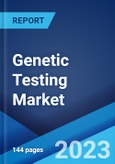The global genetic testing market size reached US$ 15.9 Billion in 2022. Looking forward, the publisher expects the market to reach US$ 29.0 Billion by 2028, exhibiting a growth rate (CAGR) of 10.37% during 2023-2028.
Genetic testing, or deoxyribonucleic acid (DNA) testing, refers to a medical technique that identifies changes in the chromosome structure or DNA sequence. It includes the collection and analysis of individual blood samples for examining the genetic condition and the chances of developing or passing various inherited disorders in laboratory settings. Genetic testing assists in providing accurate results regarding gene mutation, eliminating the need for unnecessary checkups, and making informed decisions to manage health. At present, genetic testing is commercially available in varying types, such as carrier, diagnostic, predictive, presymptomatic and prenatal testing.
Genetic testing, or deoxyribonucleic acid (DNA) testing, refers to a medical technique that identifies changes in the chromosome structure or DNA sequence. It includes the collection and analysis of individual blood samples for examining the genetic condition and the chances of developing or passing various inherited disorders in laboratory settings. Genetic testing assists in providing accurate results regarding gene mutation, eliminating the need for unnecessary checkups, and making informed decisions to manage health. At present, genetic testing is commercially available in varying types, such as carrier, diagnostic, predictive, presymptomatic and prenatal testing.
Genetic Testing Market Trends:
The increasing prevalence of genetic and chronic disorders across the growth represents the key factor driving the genetic testing market growth. This is further supported by the implementation of numerous favorable initiatives undertaken by the government bodies and non-governmental organizations (NGOs) for sensitizing masses regarding genetic testing. In line with this, the extensive utilization of genetic testing in pharmacogenomics, or drug-gene testing for examining the response of the body against certain medicines after its interaction with inherited genes, is contributing as another growth-inducing factor. Additionally, the sudden outbreak of coronavirus disease (COVID-19) pandemic has led to the widespread adoption of virtual testing and the home testing kits for sample collection purposes, which, in turn, is contributing to the market growth. The tremendous technological advancements in genetic testing techniques along with the introduction of DTC-GT (Direct-to-consumer genetic testing) kits are further propelling the market growth. Other factors, such as rising investments in the research and development (R&D) activities in the field of medical science, along with the strategic collaboration amongst top players for launching advanced personalized genetic testing kits, are creating a positive outlook for the market.Key Market Segmentation:
The publisher provides an analysis of the key trends in each sub-segment of the global genetic testing market report, along with forecasts at the global, regional and country level from 2023-2028. The report has categorized the market based on type, technology and application.Breakup by Type:
- Predictive and Presymptomatic Testing
- Carrier Testing
- Prenatal and Newborn Testing
- Diagnostic Testing
- Pharmacogenomic Testing
- Others
Breakup by Technology:
- Cytogenetic Testing and Chromosome Analysis
- Biochemical Testing
- Molecular Testing
- DNA Sequencing
- Others
Breakup by Application:
- Cancer Diagnosis
- Genetic Disease Diagnosis
- Cardiovascular Disease Diagnosis
- Others
Breakup by Region:
- North America
- United States
- Canada
- Asia-Pacific
- China
- Japan
- India
- South Korea
- Australia
- Indonesia
- Others
- Europe
- Germany
- France
- United Kingdom
- Italy
- Spain
- Russia
- Others
- Latin America
- Brazil
- Mexico
- Others
- Middle East and Africa
Competitive Landscape:
The competitive landscape of the industry has also been examined along with the profiles of the key players being 23andme Inc., Ambry Genetics Corporation (Konica Minolta Healthcare Americas Inc.), Bio-RAD Laboratories Inc., Cepheid (Danaher Corporation), Eurofins Scientific, Illumina Inc., Invitae Corporation, Luminex Corporation (DiaSorin), Myriad Genetics Inc., QIAGEN, Quest Diagnostics and Thermo Fisher Scientific.Key Questions Answered in This Report:
- How has the global genetic testing market performed so far and how will it perform in the coming years?
- What has been the impact of COVID-19 on the global genetic testing market?
- What are the key regional markets?
- What is the breakup of the market based on the type?
- What is the breakup of the market based on the technology?
- What is the breakup of the market based on the application?
- What are the various stages in the value chain of the industry?
- What are the key driving factors and challenges in the industry?
- What is the structure of the global genetic testing market and who are the key players?
- What is the degree of competition in the industry?
Table of Contents
1 Preface3 Executive Summary11 Value Chain Analysis13 Price Analysis
2 Scope and Methodology
4 Introduction
5 Global Genetic Testing Market
6 Market Breakup by Type
7 Market Breakup by Technology
8 Market Breakup by Application
9 Market Breakup by Region
10 SWOT Analysis
12 Porters Five Forces Analysis
14 Competitive Landscape
Companies Mentioned
- 23andme Inc.
- Ambry Genetics Corporation (Konica Minolta Healthcare Americas Inc.)
- Bio-RAD Laboratories Inc.
- Cepheid (Danaher Corporation)
- Eurofins Scientific
- Illumina Inc.
- Invitae Corporation
- Luminex Corporation (DiaSorin)
- Myriad Genetics Inc.
- QIAGEN
- Quest Diagnostics
- Thermo Fisher Scientific.
Methodology

LOADING...
Table Information
| Report Attribute | Details |
|---|---|
| No. of Pages | 144 |
| Published | September 2023 |
| Forecast Period | 2022 - 2028 |
| Estimated Market Value ( USD | $ 15.9 Billion |
| Forecasted Market Value ( USD | $ 29 Billion |
| Compound Annual Growth Rate | 10.5% |
| Regions Covered | Global |
| No. of Companies Mentioned | 12 |







![Direct-to-consumer (DTC) Laboratory Testing Market by Application (Genetic Testing {Ancestry, Carrier Status, Disease Risk [Cancer, Neurological, Cardiac]}, Diabetes, COVID, STD, Routine, CBC), Sample Type (Saliva, Urine, Blood) - Global Forecast to 2030 - Product Image](http://www.researchandmarkets.com/product_images/12474/12474710_60px_jpg/directtoconsumer_laboratory_testing_market.jpg)

